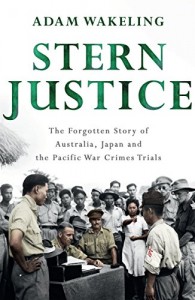 Adam Wakeling
Adam Wakeling
If you’re looking for a ripping yarn or a feel good story, you’ve come to the wrong place. The prologue deals with the harrowing reality of an execution. Somehow this kind of death, whether some may deem it justified or not, is simply horrible.
Then you move into the first phase of the book and the word “stern”, which somehow resonated with me, becomes more apparent. In addition to meaning harsh and severe, it also refers to the rear end of a boat, the bit that comes along after everything else and I cannot but think that Adam may have had this in mind while conjuring up the title, for it’s all about the mopping up and apportioning of guilt on the Pacific front after WWII.
I couldn’t help but also reflect on how supreme leaders, the Kaiser in WWI and the Emperor in WWII, got away with it virtually unscathed, protected by some who deemed them worthy. Perhaps the truth lies in the fact that they were both so far removed from reality they really didn’t have a clue about what the battle fronts were like. However, you can’t help but believe that the appointment of General MacArthur to oversee post war Japan was a masterstroke and he, as much as anyone, wanted the emperor alive because of his influence over the psyche of the Japanese people.
As you move into the second of four phases of the book, the legalities and personalities of the legal minds involved in such a massive prosecution come to the fore. The disagreement among lawyers and the convoluted approach to the whole thing takes up many chapters but then one is shaken up again by the testimony of Warrant Officer Bill Sticpewich who survived the unimaginable horrors of the Sandakan death march. That the camp commandant Hoshijima was in denial about his appalling treatment (though “appalling” seems wholly inadequate for this man) says a lot about the mentality of the Japanese military machine. Added to that was Captain Takakuwa’s cruelty during the march. They really were out of touch with reality and brutality on an extreme scale, for them, was normal. There was also the fact that many Japanese viewed martyrdom as something to be proud of.
Then there’s Banaba Island on Kiribati, where 200 locals were executed 4 days after the war ended. The atrocities here were also committed by other nationalities, such as Formosan (now Taiwanese) who were coerced into assisting the Japanese, occasionally willingly, mostly for survival. Their trials took place in Rabaul, completely under the control of Australia at that time, so it was an all Australian affair.
During the trails, the fact that Russia had perpetrated most of what Japan was accused of doing and yet went unpunished was raised more than once. It is claimed, with some right, that more died in Russian captivity than in Japanese captivity yet they got off scot free.
Questions were also raised about Australian troops raping Japanese women with gay abandon. How quickly we are reduced to animal behaviour!
Of course, WWII was now over and, with each succeeding month, interest in retribution continued to wane as people got on with their lives and moved ahead. Prosecutions and come-uppance were the province of those who had gone through the war at the coal face and knew the reality of what had been, but then the Korean War surfaced and became the more immediate concern.
The final round at Manus Island is also covered and an interesting concluding chapter looks at the rights and wrongs of the whole affair; like how one accused man was released and later became prime minister of Japan.
It’s a detailed document that will appeal to those interested in war and its side effects and gives insightful information into realities often overlooked.
